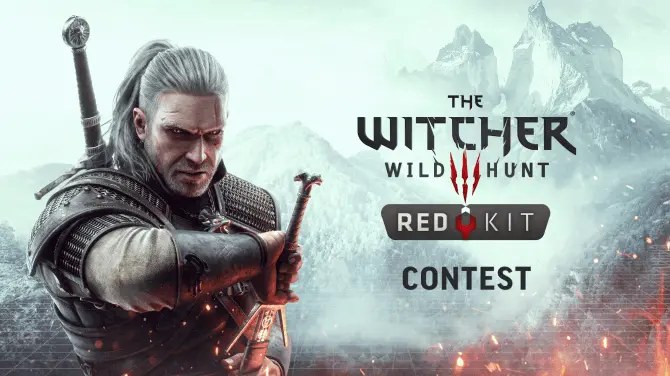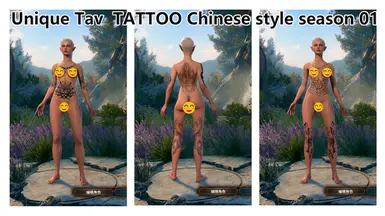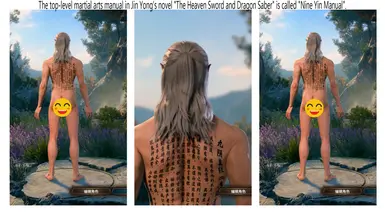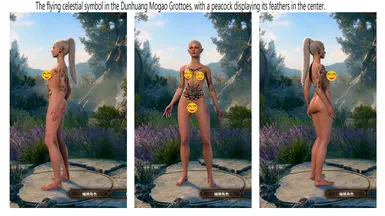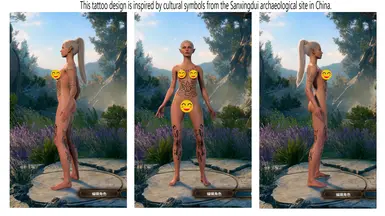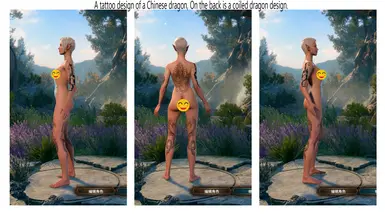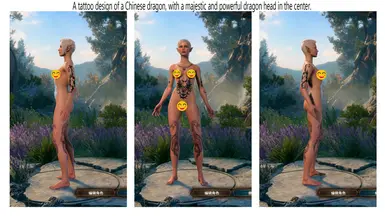About this mod
This is a set of full-body tattoos for Unique Tav, rich in Chinese elements, this set of tattoos currently has a total of five different design
中文说明:欢迎喜欢博德之门3的玩家加入游戏交流QQ群:372776014
- Requirements
- Permissions and credits
- Changelogs
In this series of tattoos, I still incorporate elements of Chinese culture. Chinese culture, after thousands of years of integration and development, has always adhered to the principle of inclusiveness. Every culture deserves respect.
I'm going to cover the cultural backstory of each tattoo individually, some of which have been covered before. You can see inside this post
Chinese style tattoos give you more choices
--------------------------------------------------------------------------------------------------------------------
Installation:
Download and extract my file package, which contains a total of 5 different tattoos.
Only one full-body tattoo can be used at a time, so you need to select the tattoo you like and replace it accordingly. The file path for replacement is as follows:
C:\Program Files (x86)\Steam\steamapps\common\Baldurs Gate 3\Data\Generated\Public\Shared\Assets\unique_tav\BODY\TATTOO
Future Update Plan:
I will be creating more tattoos with Chinese cultural elements in the future. Stay tuned for updates and exciting new designs!
--------------------------------------------------------------------------------------------------------------------
Sanxingdui
Sanxingdui, located in Guanghan City, Sichuan Province, China, is an important archaeological site and considered one of the treasures of prehistoric civilization in China. Discovered in 1986, the site dates back to the late Bronze Age, around 1200-1100 BCE.
The discovery of Sanxingdui has garnered great attention and astonishment due to the large number of unique and exquisite artifacts found, including bronze objects, jade, ivory works, and pottery. The most remarkable findings are two sets of bronze sculptures in the form of dragon-shaped objects known as the "divine trees" and "gold masks". These bronze sculptures display distinctive designs, exquisite craftsmanship, and demonstrate a high level of artistic skill and technological achievement.
Sanxingdui culture is also renowned for its extraordinary murals and reliefs, particularly those depicting enigmatic human faces and animal figures. These art pieces showcase the unique aesthetic concepts and cultural significance of the Sanxingdui culture.
The discovery of Sanxingdui provides important clues for studying ancient Chinese civilization, as well as the social, political, and religious aspects of the Bronze Age. It has led to a re-evaluation of the development and complexity of ancient Chinese history. Sanxingdui has been listed as a key national cultural heritage site and has become an important area of research in Chinese archaeology and cultural heritage studies.
Nine Yin Manual
The "Nine Yin Manual" is a top-level martial arts manual featured in the famous wuxia novel "The Heaven Sword and Dragon Saber" by Jin Yong. This manual plays a crucial role in the novel and is portrayed as possessing immensely powerful martial arts techniques and mysterious powers.
According to the novel's plot, the Nine Yin Manual was obtained by Zhang Wuji, the founder of the Ming Cult. It is aimed at practitioners of the Nine Yang Manual and through its cultivation, one can attain great martial arts prowess. The internal energy cultivation method of the Nine Yin Manual is regarded as supreme, enhancing a practitioner's strength, speed, endurance, and granting extraordinary combat abilities.
However, the "Nine Yin Manual" also sparks controversy due to its malevolent nature. According to the story, practicing the Nine Yin Manual requires assimilating nine kinds of evil toxins, leading practitioners to become cold-blooded and ruthless, losing their sense of justice and morality. Consequently, the Nine Yin Manual becomes a coveted object among various factions in the novel and presents a burden and challenge for the protagonist, Zhang Wuji.
Although the "Nine Yin Manual" exists solely within Jin Yong's fictional universe, it captivates readers' imagination as a legendary martial arts manual. It has become an integral part of Chinese martial arts culture, finding widespread application and interpretation in numerous film adaptations, television series, and video games.
Left Green Dragon, Right White Tiger
In Chinese culture, "Left Green Dragon, Right White Tiger" refers to the mythical creatures Qinglong (Green Dragon) and Baihu (White Tiger), which are two of the Four Divine Beasts. According to traditional directional beliefs, the Qinglong represents the east, while the Baihu represents the west.
The Qinglong symbolizes authority, power, and auspiciousness. It is often depicted as a majestic green dragon, exuding strength and elegance. The image of the Qinglong holds significant importance in Chinese culture, often associated with imperial power and the emperor. During ancient imperial times, the Qinglong was used as a symbol of the monarch, representing their divine right to rule and the prosperity of the nation.
The Baihu, on the other hand, symbolizes bravery, fierceness, and protection. It is portrayed as a massive white tiger, displaying dignity and strength. The Baihu also plays an important role in Chinese culture, often regarded as a guardian deity that protects warriors and families. In ancient military culture, the Baihu was frequently used as a symbol for armies or incorporated into the names of military units.
The expression "Left Green Dragon, Right White Tiger" is commonly used to describe a balance or opposition between two forces or powers. It is often used metaphorically to depict competition or conflict between two parties, whether in politics, business, or other domains. The phrase carries symbolic and totemic significance, playing an important role in Chinese culture and finding wide application in art, literature, traditional architecture, and other areas.








